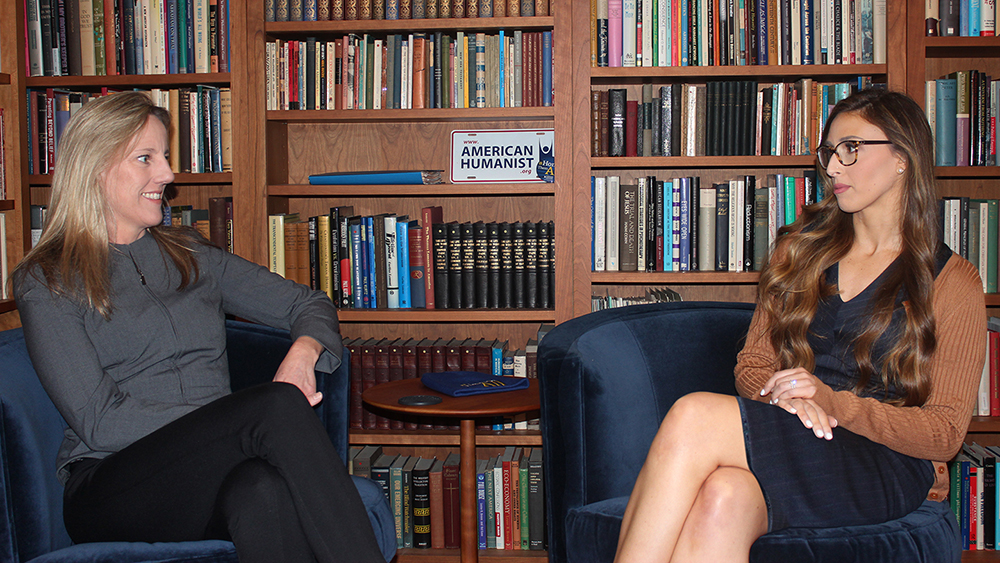Before (and after) the Court: The Humanist Interview with Monica L. Miller

Monica L. Miller is senior counsel for the American Humanist Association (AHA). She obtained her BA from Pitzer College in 2008, her master’s in public administration from Columbia University in 2009, and three years later she graduated cum laude from Vermont Law School.
Since joining the AHA in 2012, Miller has vigorously defended the constitutional mandate of separation of church and state by litigating Establishment Clause cases across the country. She has served as lead counsel in over twenty-five federal cases, including before the US Supreme Court and the US Courts of Appeals for the Fourth, Fifth, Ninth, Tenth, and Eleventh Circuits. Miller has presented oral arguments before the Courts of Appeals for the Fourth Circuit (twice), Fifth Circuit, and Eleventh Circuit. She has filed a number of briefs in the US Supreme Court and served as counsel of record in Maryland-National Capital Park and Planning Commission v. American Humanist Association, challenging a forty-foot tall Latin cross on government land in Bladensburg, Maryland, dedicated to US war veterans. On February 27, 2019, Miller presented oral arguments before the Supreme Court in the case.
In pursuit of her concern for fundamental rights, Miller is also an attorney for the Nonhuman Rights Project, working to obtain common law personhood rights for nonhuman animals. This work has captured the interest of the world’s leading legal scholars, scientists, and journalists and is featured in an HBO documentary, Unlocking the Cage.
I had a chance to speak with Miller when she was in Washington, DC, following her Supreme Court appearance.
JENNIFER BARDI: Just last week you presented oral arguments before the US Supreme Court, making the case for the Bladensburg cross to be moved, reshaped into something nonsectarian, or reassigned to private ownership. This is a case you argued successfully in the Fourth Circuit Court of Appeals two years ago. What was it like standing before the nine justices of the highest court in the land?
MONICA MILLER: It was intimidating at first. After the justices walked in and were getting situated, there was a brief moment where Justice Ruth Bader Ginsburg (RBG) peered her head over the table, made eye contact with me, and cracked a little grin. My heart was pounding, and for a brief moment I thought, what am I doing here?!
I looked over at my opponents’ full table—each seat was occupied by a man with eons of Supreme Court experience (just google Neal Katyal, Michael Carvin, and Jeff Wall) and surrounded by very helpful looking junior and senior associates (closer to my age) who were unloading documents from briefcases for them. As I started unloading my own bag of files, a clerk approached me and jokingly asked if this was a “case of abandonment” in reference to the fact that I had three empty seats to my left. “No sir, just me today,” I quipped, and then took a huge swig of water and sat back down. The deputy solicitor general (Wall) also came over to shake my hand and whispered something to the effect of “you’ve got this, kid” (not those words, but the gist), which I took as a kind gesture.
As I was giving my opening remarks, I did my best to ignore the fact that the chief justice of the US Supreme Court was staring right at me, listening to my every word, and that, ultimately, the whole world would have access to my remarks on the Supreme Court website. No pressure, right?!
But once the justices starting throwing questions at me, it didn’t feel much different than any other case I’ve argued, except that the questions were coming from nine humans in black robes rather than your standard three at the circuit level. That was, of course, until RBG started saying something to me; that felt surreal. It was in response to a question from Justice Gorsuch about the cross-shaped steel beams that were pulled from the rubble of the World Trade Center after 9/11. He asked if my position would prohibit cities and states from duplicating that cross to memorialize 9/11. I started to answer that it would depend on how it was displayed when she interjected [the following comes from the official transcript]:
JUSTICE GINSBURG: Didn’t you answer that it doesn’t exist in splendid isolation?
MILLER: Exactly. It does not exist in isolation, yes, it’s—it’s in a museum.
In my head I was screaming, RBG JUST SPOKE TO ME! ME!!! AND SHE’S TRYING TO HELP ME! I CAN’T WAIT TO TELL MY MOM ABOUT THIS!
BARDI: Those who were present for the oral arguments (or listened to audio since) remarked at how intellectually rigorous the exchanges were between the Supreme Court justices and the attorneys on both sides. There was a feeling that the justices’ questions indicated the case is hardly a slam-dunk for the opposition, which wants the giant, crumbling cross to remain as is. What do you think?
MILLER: It’s interesting because I walked in certain I didn’t have five votes in our favor. In fact, one of the kindest things anyone said to me before the arguments was, “don’t worry, Monica, we know you don’t have five votes, and it’s not your fault. You’ve done everything possible to win, and you should win, but we can’t control who’s on the court.” Others concurred. It was a relief to know that my lawyer friends at the other church-state separation organizations won’t blame me if we lose.
That said, I left the courtroom with a sense that it’s not over yet. As I’ve always maintained, there’s no principled way to rule against us. These are the options: 1) carve out an arbitrary exception for old monuments (even when, as here, they’re actively used and promoted by the government on an annual basis); 2) declare that the Latin cross honors everyone: Jews, Muslims, and atheists (the government’s argument); or 3) overrule seventy years of precedent and hold that the Establishment Clause permits the government to favor one religion over another (the American Legion’s argument).
BARDI: Some characterized Samuel Alito as hostile, Neil Gorsuch sarcastic, and Sonia Sotomayor as helpful. And of course Ruth Bader Ginsburg is such a powerful presence. Were you surprised by any of the justices, either by their demeanor or the way they approached the case?
MILLER: I really wasn’t surprised at all. I expected Justice Sotomayor to be my most vocal ally (with RBG asking a few poignant questions), Justice Thomas to be silent with his chair reclined, Justice Breyer to ask me about history, Justice Gorsuch to ask me about the Lemon test and maybe standing (he asked about both), and Justice Alito to me ask me a series of impossible hypotheticals (which he did). I wasn’t sure about Chief Justice Roberts or Justice Kavanaugh. I read Kavanaugh’s lower court opinions and cited a few key quotes of his in my brief. For instance, he agreed with Justice Kennedy that a large Latin cross on the roof of a city hall would clearly violate the Establishment Clause. And he also noted a difference between legislative prayer and religious monuments, the latter being more problematic. Chief Justice Roberts hasn’t said a whole lot on the Establishment Clause, but I know he cares about the integrity of the court. Overruling seventy years of precedent doesn’t exactly align with that goal. So we’ll see!

For more of this interview, check out the May/June Humanist, out April 19 and available at TheHumanist.com April 23!
